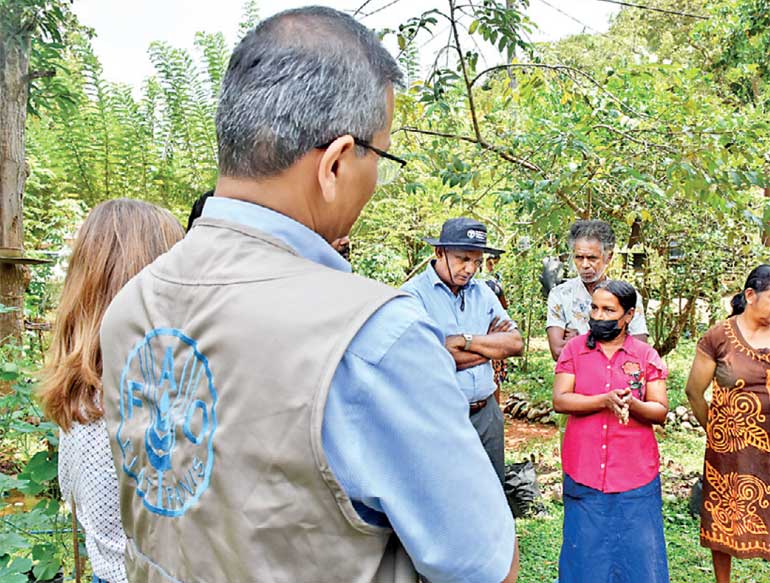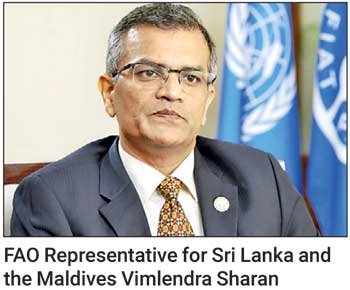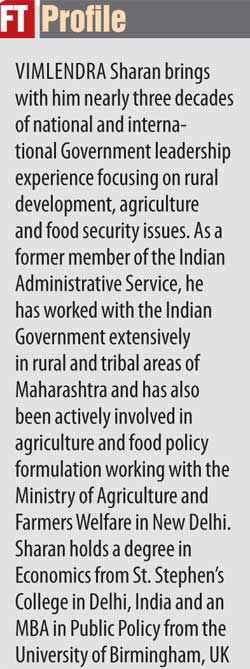Monday Apr 28, 2025
Monday Apr 28, 2025
Thursday, 16 March 2023 01:03 - - {{hitsCtrl.values.hits}}

Stresses priority is to restore supply of essential inputs to agriculture at an affordable price
Sri Lanka is currently in a better position in terms of food and crop security, says the UN Food and Agriculture Organisation (FAO) Representative for Sri Lanka and the Maldives Vimlendra Sharan. In this interview, he also says the agriculture sector in Sri Lanka needs several sustained initiatives to fully recover. Here are excerpts.
 Q: What is the status of food and crop security in Sri Lanka? Is Sri Lanka in a better position now than it was in 2022?
Q: What is the status of food and crop security in Sri Lanka? Is Sri Lanka in a better position now than it was in 2022?
A: Short answer is “Yes”. Let me elaborate a bit. Sri Lanka’s agricultural sector faced multiple challenges in 2022. While the scarcity of fertiliser deprived crops of essential nutrients, the rising inflation and the resultant price hikes of fuel and other inputs placed farmers, particularly smallholder farmers in a vulnerable position. The joint Crop and Food Security Assessment Mission carried out by FAO and WFP in March 2022, indicated that 6.3 million Sri Lankans were food insecure as high food prices constrained the ability of many households to access food. As a result, coping mechanisms such as consuming less nutritious food and skipping meals were being adopted by vulnerable households, leading to a deterioration in the food and nutrition security situation in Sri Lanka. CFSAM also reported a 40-50% fall in production of paddy and maize besides impacting tea, rubber and other plantation crops.
The Government of Sri Lanka, in collaboration with its bilateral and multilateral partners, including the UN Agencies worked towards stemming this bleed by bringing in and distributing the much-needed fertiliser – Urea, MOP and TSP to the paddy farmers.
FAO, via valuable funding provided by donors including the USA, United Kingdom, Japan, Australia, Sweden, New Zealand, Canada, and the European Union, has provided Sri Lanka’s agriculture and fisheries sectors with vital support to ensure Sri Lankan farmers and fishers do not abandon their livelihoods and are given the necessary boost to continue contributing towards making Sri Lanka a food secure nation once more.
As we speak there is adequate urea, MOP and TSP in the country to cater to the requirements of the Yala cropping season and more. Some pricing issues do remain, especially for MOP but I am confident that the Government will be able to resolve it soon. With a normal Yala in 2023, I hope to see the agriculture sector bounce back. However, we will still need to keep a very close eye on input provisions for at least another two to three seasons.
Q: What does the agriculture sector in Sri Lanka need to fully recover?
A: The Crop Prospects and Food Situation report raised concerns over the continued constraints that exist in accessing agricultural inputs. Although fertiliser is no longer scarce and available for purchase, it is still beyond the purchasing capacity of many vulnerable smallholder farmers. The prices of essentials including the cost of labour and materials including pesticides and herbicides, and fuel have skyrocketed, hampering access to them. In fact, the cost of cultivation for paddy has gone up by approx. 300% as compared to 2019.
Therefore, the priority is to restore the supply of essential inputs to agriculture at an affordable price, so that farmers can access inputs required for cultivation. At the same time, the local agriculture sector, particularly paddy farming, requires a fresh outlook where innovative and modern technologies need to be introduced to help farmers boost the productivity of their crops and adapt to climate change impacts. The current yield gap in paddy is nearly 40% and if this can be partially bridged, the country will be able to free thousands of acres of low productive paddy lands for other alternative uses.
Very recently, FAO in collaboration with USAID and Government counterparts and other stakeholders concluded a two-day workshop to analyse this issue and produce an “action paper”. Using the pathways identified, FAO will work very closely with Government agencies to help improve paddy productivity in the country, which has plateaued over the last couple of years. A similar workshop in maize is also planned in the coming months.
 Q: What role does FAO play in supporting the recovery of Sri Lanka’s agriculture sector?
Q: What role does FAO play in supporting the recovery of Sri Lanka’s agriculture sector?
A: FAO launched a multi-pronged approach in garnering support and assistance for Sri Lanka’s ailing agriculture sector and especially its vulnerable smallholder farmers. Using funding available from UNCERF, USAID and EU, FAO imported over 12,000 tons of urea to be distributed to nearly 250,000 smallholder paddy farmers. Another batch of urea is likely to come in using funds available from Japan. With USAID funding FAO has also imported 36,000 tons of TSP to be distributed to over 1 million paddy farmers. FAO has also reached out with unconditional cash grants to over 11,000 fisher folk through funds provided by CERF and FCDO, UK and to 50,300 farmers through funds provided by USAID.
While material inputs such as fertiliser were vital, there was also a pressing need to ensure that adequate training and capacity building of farmers took place. The FAO in collaboration with DFAT, Australia has launched a substantive program to train farmers in securing GAP certification in Monaragala, Badulla and Mullaitivu districts while also setting up entrepreneurial school gardens in nearly 200 schools in the North, Central and Uva provinces. With help from New Zealand, FAO has reached out to families of 2,250 severely malnourished children to provide them with supplementary food and help establish home gardens to enable a sustained supply of vital nutrients.
Very recently, we launched a very timely campaign in collaboration with the EU to train nearly 41,000 farmers on Integrated Plant Nutrient Management Strategies, thus enabling them to improve the fertiliser use efficiency in their farms. We have also collaborated with the EU to train 1,000 paddy farmers in producing certified paddy seeds to meet the increasing demand for good quality seeds in the country. The Government of Canada has also collaborated with us in helping vegetable farmers growing chilli, red onion and big onion seeds by providing them with rain shelters and micro irrigation facilities.
Q: How does FAO select which farmers receive support?
A: Beneficiary selection is always a very crucial step in providing assistance during emergencies. Besides ensuring minimal inclusion and exclusion errors, we also need to guard against any corruption or abuse, including sexual abuse of the beneficiary population. FAO has very strict criteria and guidelines laid down in this regard and we have been extremely careful in ensuring that these were understood by all agencies associated with beneficiary selection.
As our target population is vulnerable smallholder farmers, land holdings become a very important basis for beneficiary selection. We also take into account the earning, which such households have from other sources to determine their eligibility. Within this basis, priority is given to women farmers and women-headed households.
To ensure accuracy, the beneficiary lists are published at the Agrarian Service Centres for farmers to see and register their grievances if any. We have also used an independent third party to carry out a random sample survey for inclusion and exclusion errors and there have been instances of beneficiary lists being cancelled and drawn up afresh, when found with unacceptable levels of errors through these independent surveys.
The only exception to this selection criteria is the USAID-funded 36,000 tons of TSP which is being provided to all 1,154,522 paddy farmers in the country. The amount of TSP going to each farmer will depend on the land holding and the advised application depending on the soil sample tests run by the Government for each of the agro zones.
Q: How can Sri Lanka build resilience against future shocks like climate change and climate related disasters and ensure food security for all citizens?
A: FAO is already supporting several sectors including agriculture, fisheries, and livestock in adapting to climate change impacts. This is a reality that we will not be able to avoid – extreme weather events brought on by climate change as well as the unpredictability of weather patterns have hampered traditional cultivation methods. Adaptation is the only way to mitigate a food insecurity crisis in the future. As FAO we are working very closely with the Ministry of Agriculture and the Ministry of Environment to mitigate these risks and strengthen Sri Lanka’s food security. Adapting to climate change is and will remain a cross cutting theme within all our interventions, whether they be through the introduction of better seed varieties, or conservation agriculture or crop diversification or IPNM.
Discover Kapruka, the leading online shopping platform in Sri Lanka, where you can conveniently send Gifts and Flowers to your loved ones for any event including Valentine ’s Day. Explore a wide range of popular Shopping Categories on Kapruka, including Toys, Groceries, Electronics, Birthday Cakes, Fruits, Chocolates, Flower Bouquets, Clothing, Watches, Lingerie, Gift Sets and Jewellery. Also if you’re interested in selling with Kapruka, Partner Central by Kapruka is the best solution to start with. Moreover, through Kapruka Global Shop, you can also enjoy the convenience of purchasing products from renowned platforms like Amazon and eBay and have them delivered to Sri Lanka.
Discover Kapruka, the leading online shopping platform in Sri Lanka, where you can conveniently send Gifts and Flowers to your loved ones for any event including Valentine ’s Day. Explore a wide range of popular Shopping Categories on Kapruka, including Toys, Groceries, Electronics, Birthday Cakes, Fruits, Chocolates, Flower Bouquets, Clothing, Watches, Lingerie, Gift Sets and Jewellery. Also if you’re interested in selling with Kapruka, Partner Central by Kapruka is the best solution to start with. Moreover, through Kapruka Global Shop, you can also enjoy the convenience of purchasing products from renowned platforms like Amazon and eBay and have them delivered to Sri Lanka.